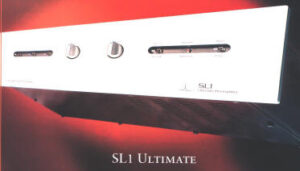POSTED 03/31/2002
This review is much more than the result of a number of listening sessions over a two year period. It is really the story of one person’s quest for the attainment of the goal of having exceptional music reproduction available at the turn of a dial and the drop of a needle. It is the culmination of a journey from my first Lafayette receiver many years ago that was purchased with paper-route money, through the highway of solid state and forests of interesting but ultimately unsatisfying speakers. It is the sum of experience with many phono cartridges and different ways of turning the miniscule voltages from those cartridges into sound in a listening room. Most of all, though, this review completes – I strongly suspect – a yearning for a reference component that does its job so well that when the upgrade bug bites, it is not on the potential hit list.

The CAT Ultimate preamp is the best phono preamp I’ve heard. Here’s a sampling of others that have passed through the system:
Threshold Fet-10P
Levinson No. 26 (and used as just a phono stage, ala the No. 25)
Benz-Lucaschek PP-1, versions 1 and 2
EAR 834P
AHT-PDM
Nagra PL-P (briefly)
CJ PV-12 (briefly)
Most of these phono stages were used with passive preamps. Let’s address the passive preamp issue first. I’ve used several designs that were built in-house. They all share these traits: remarkable transparency and low level detail, very good imaging, a small reduction in bass power, and a somewhat larger lessening of dynamics. The negative aspects of a passive preamp can mostly be ignored, as the benefits – significant cost savings, no noise, and again, that reference level transparency – tend to outweigh them.
When compared to the best passive designs, the CAT’s line stage has similarly excellent low-level resolution and purity, pinpoint imaging ability, with the expected increases in bass power and overall dynamic ability that one can get when using an active line stage. It would be a mistake to assume that the line stage is just okay from this short description, since the abilities of a good passive preamp can be quite extraordinary. I immediately appreciated the powerful driving ability of the CAT’s line stage. I would estimate the improvement in the bass range to be about 10-15%. Overall, the improvements were small but musically significant.
The phono section is where the CAT really shines. Smooth, dynamic, high resolution, exceptional bass power and depth, high frequencies that seem to go right out to RF, and the rare ability to present seemingly everything on the big disk without any hint of emphasis in any particular part of the music spectrum, are just some of the qualities I consistently enjoyed. Listen to Foggy Mountain Breakdown on the McNeely-Levin-Skinner Band’s album After Midnight (Sheffield TLP-30). If your system can keep the banjo in complete control and fixed in space throughout the cut, you are undoubtedly enjoying some of the finest music reproduction possible today. Most other preamps – not to mention cartridges – have serious problems unraveling this complex cut as the musicians really let loose and take turns on solos.
This characteristic of the CAT is the most rewarding: the ability to let one hear whatever it is fed, without compression or change. Great recordings are presented with seemingly limitless resolution, consistently resulting in a “you are there” sensation. Small system changes are easily observed. It is very clear which VTF or VTA settings are optimal on the turntable. (VTF: Just enough to prevent mistracking. VTA: Adjust for best center image.) Cable auditions are usually quick and easy because of the high resolution of the CAT. Those overnight auditions from your local dealer now give you plenty of time to hear a new component’s unique qualities, often enabling a purchase decision in hours instead of days. Poor-sounding components and recordings are easily identified, but you are richly rewarded when everything is right.
Phono cartridges used included Benz Ruby, vdH Black Beauty (1 mv version), Shelter 501-II and 901, Koetsu Black, Rosewood Signature, and Urushi. At a certain setting on the volume control, roughly 2 o’clock, tube noise starts to be an issue and can be heard at the listening seat (YMMV depending on the rest of your system). To keep tube noise in check, cartridges with outputs greater than 0.5 mv are recommended with the standard tubes. There’s just one other item on my Ultimate Wish List: finer control of volume, as the steps seem a bit too large at times. On the other hand, the long-handled switches, especially the very useful Mute switch, make this preamp a pleasure to operate.
The Ultimate is proving to be very reliable. With over 2500 hours of use over about 2 years, I replaced one phono stage tube that became noisy after about a year of use. I am not a big fan of tweaks, not because they are not effective, but because I tend to focus on component upgrades instead of dots, cones, and other “add-ons”. However, I found the sound benefited from using a large AQ Sorbothane foot under each preamp foot.
At $6000, the CAT Ultimate with phono should be considered a bargain. Other top phono stages are running in the $3500-8000 range; competitive line stages are playing in the same wallet-emptying league. Not to say that $6k is cheap, but similar performance is often priced at $8000+, and most often requires an additional interconnect between the separate phono- and line-stages. I have often recommended a used CAT when folks are looking for a great phono stage on a budget. But it is even easier to recommend a new Ultimate for those looking for top performance from an easy to use, reliable, highly refined design.
Overall Rating: 10 LPs

